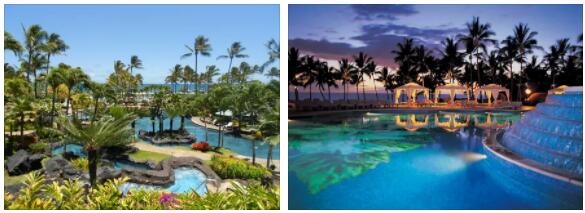Haleakala Crater
Haleakala Crater, Red Hill, volcano and highest point on the island of Maui, Hawaii; 3057 m, most recently active in the middle of the 1700s. The volcano and its 600-1000 m deep and almost 50 km2 large crater is part of Haleakala National Park, which since its establishment in 1961 has been the island’s largest attraction.
- Timedictionary: Offers a list of largest cities in Hawaii.
Kahoolawe
Kahoolawe, a volcanic island in the state of Hawaii, USA; 117 km2, nickname: The Forgotten Island. Following popular pressure, the island was again handed over to Hawaii in 1994, after being evacuated in 1941 to be used by the U.S. Pacific Fleet for test explosions. Before that time, the island served as a penal colony and cattle breeding area (1917-41). The highest point on the hard-hit and almost uninhabited island is Lua Makika (450 m).
Kilauea
Kilauea, The Drive-in Volcano, 1243 m high shield volcano on the southeastern part of Hawaii Island; it has been in almost constant eruption since 1983. The eruptions usually take place in the 13 km2 crater, Kilauea Caldera, where the thin-flowing basaltic lava from time to time meets the lava lake, Halemaumau, which lies in the crater. Most of the lava that covers the volcano has formed within the last 1100 years.
Kilauea is the youngest of the island’s five volcanoes, and together with the neighboring volcano Mauna Loa, it is a major tourist attraction. Both are part of Hawaii Volcanos National Park.
- Transporthint: Overview of Hawaii, including population, history, geography and major industries.
Lanai
Lanai, a volcanic island in the state of Hawaii, USA; 363 km2, 3102 inhabitants (2010), of which approx. 50% of Filipino descent. Almost the entire island is owned by the American group Castle & Cook, which in 1961 took over it from the previous owner, the food company Dole. From the construction of the first pineapple plantation (Dole, 1922) to the early 1980s, when operations were abandoned, the economy was based on the cultivation, processing and export of pineapples. Since then, tourism has become the island’s main source of income. The highest point is Lanaihale (1027 m).
Maui
Maui, The Valley Island, the second largest of the Hawaiian Islands; 1886 km2, approx. 144,400 inhabitants (2010). The island is made up of two extinct volcanoes, Puu Kukui (1760 m) in the west and Haleakala (3057 m) in the east with a flat headland of solidified lava in between. Here lies the capital, Wailuku, with the neighboring town of Kahului; A total of 41,600 inhabitants. Along the coast are a large number of small towns and resorts.
The interior of the island is occupied by cattle farms, sugar plantations and contrasting mountain landscapes with both rainforests and deserts. More than 1 million tourists visit Maui every year. The attractions include Haleakala Crater, botanical gardens, kilometers of sandy beaches and a pleasant and in many places sunny tropical climate.
Mauna Kea
Mauna Kea, White Mountain, extinct shield volcano on Hawaii Island, USA; 4205 masl, the height above the seabed 10,023 m. In addition to the impressive size, the volcano is known for the high-lying lake Lake Waiau, a remnant of the ice age, when the top was covered by an approx. 100 m thick ice cap. See also Hawaii (geology) and volcanoes.
Mauna Kea Observatory
is located near the top, where the extremely stable and dry air makes it one of the world’s best astronomical observatories. It is with the American Keck telescopes and the Japanese Subaru, all in the 8-10 m class, as well as a number of smaller telescopes and two microwave antennas one of the world’s largest.
Mauna Loa
Mauna Loa, The Long Mountain, active shield volcano on Hawaii Island, USA; 4169 m. Since 1832 it has been in eruption more than 30 times. The last eruption was in 1984. Many of the eruptions come from the main crater, the Mokuaweoweo Caldera (10 km2), others from lower-lying fracture zones along the flanks.
The lava flows from Mauna Loa cover over 5000 km2 or almost half of the island’s area. See also Hawaii – geology and volcanoes.
Molokai
Molokai, the fifth largest of the Hawaiian Islands; 671 km2, 7400 inhabitants (2000). Following the closure of the last pineapple plantation in 1982, Molokai has sought to create renewed economic growth through tourism, but so far with only limited success. Almost half of the island is owned by Molokai Ranch.
Niihau
Niihau, The Forbidden Island, the westernmost of the main islands of the state of Hawaii, USA; 187 km2, 130 inhabitants (2009). The island has been privately owned since 1863, when a Scottish family bought it from King Kamehameha 4. Communication with the outside world is sparse and visits are only allowed by special arrangement. The landscape is dominated by a semi-arid, volcanic steppe, which is used for cattle and sheep breeding. Almost all the inhabitants are native Hawaiians.
